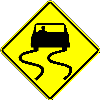Global Navigation

Main Navigation
Sub-Navigation

Content
Did you hear the one about the biker who had someone pull out in front of him? He jammed on the brakes and the tires squealed as the bike skidded sideways sending him to the asphalt. Or how about the one about the biker who went into a curve a little too fast? She hit the brakes and the rear wheel slid out from under her as her bike scraped its way to the ditch. What do these two stories have in common besides the obvious damaged bike and the minimum of a bruised ego? In both instances, the rider tried to use more traction than was available.
When the rubber meets the road, there is nothing more critical to us than traction. What is traction? According the Merriam-Webster OnlineŽ, traction is "the adhesive friction of a body on a surface on which it moves." In other words, it's the friction that exists between our tires and the road on which we're riding. Obviously it depends on a number of factors and it's not always the same. Freshly laid asphalt roads, traffic worn concrete highways, and granite gravel driveways all provide different amounts of traction. Worn tires provide less traction than new tires, as do cold tires versus heated tires. Add some rain and total traction is even less.
The importance of traction
The interesting thing about traction is that it is not something we can store up for future use. We have all the traction we can have at any instant. It's kind of like the cash in our pocket. The amount of it varies all the time. Sometimes we have more; sometime less. But when it's gone, there is no more. Sure we can do things to replenish the supply like write a check or take a cash advance, but that delays the process a little. If we want to buy something and we don't have enough cash, we have to find an alternative means of paying.
Sidebar
Footer
Copyright 1996-2015 Chuck Miles All Rights Reserved
All information on this site, including all articles, are copyrighted materials belonging to Chuck Miles.
Design: Made in Austria | Author: G. Wolfgang



